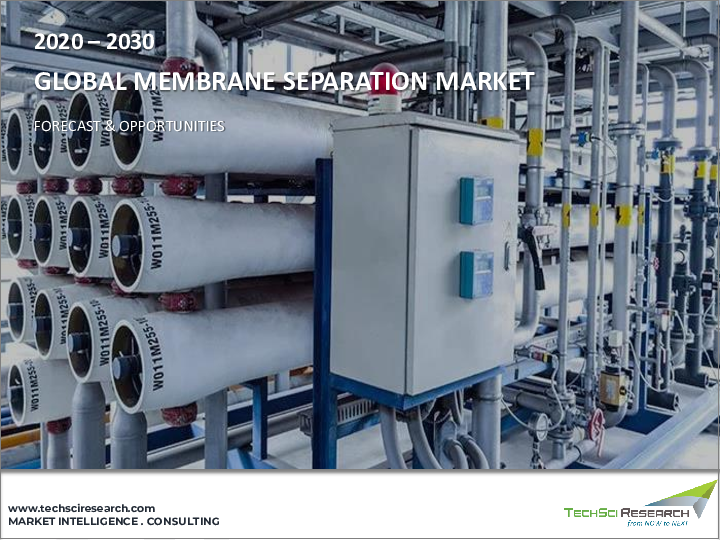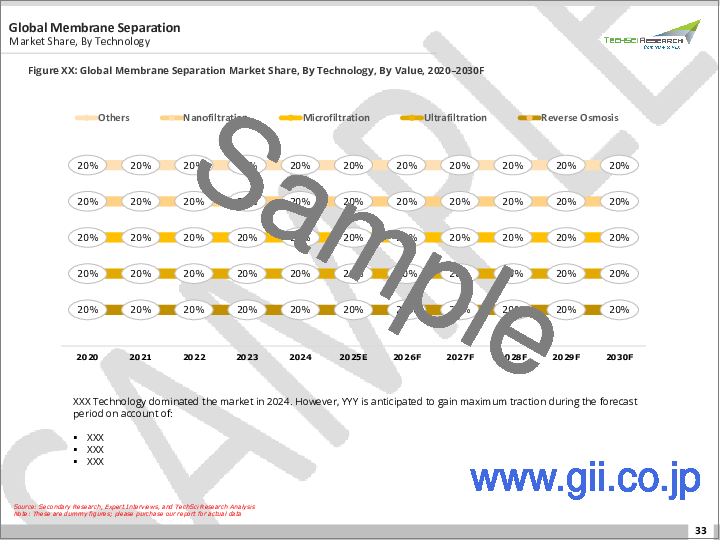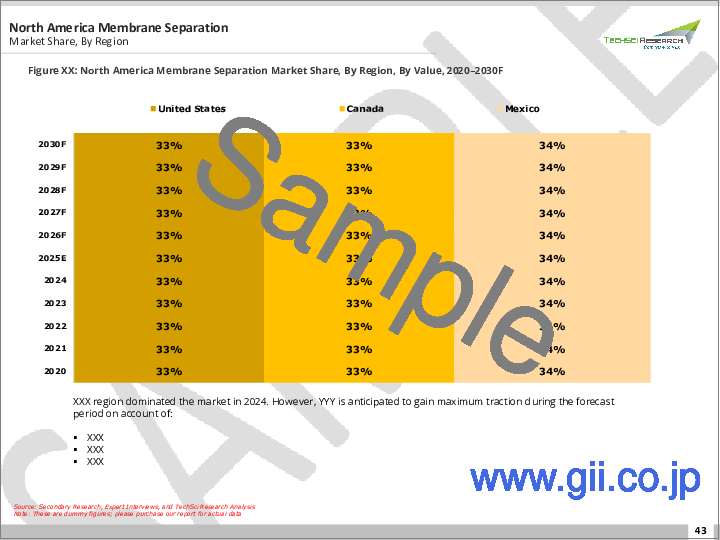|
|
市場調査レポート
商品コード
1763916
膜分離市場- 世界の産業規模、シェア、動向、機会、予測、材料別、技術別、用途別、地域別セグメント、競合、2020年~2030年Membrane Separation Market - Global Industry Size, Share, Trends, Opportunity, and Forecast, Segmented By Material, By Technology, By Application, By Region & Competition, 2020-2030F |
||||||
カスタマイズ可能
|
|||||||
| 膜分離市場- 世界の産業規模、シェア、動向、機会、予測、材料別、技術別、用途別、地域別セグメント、競合、2020年~2030年 |
|
出版日: 2025年06月30日
発行: TechSci Research
ページ情報: 英文 185 Pages
納期: 2~3営業日
|
全表示
- 概要
- 目次
膜分離の世界市場は、2024年には308億3,000万米ドルとなり、2030年には512億米ドルに達すると予測され、予測期間中のCAGRは8.66%で成長します。
清潔な水へのニーズの高まり、工業化の進展、環境規制の強化などにより、市場は着実に拡大しています。膜分離技術は、水・廃水処理、飲食品加工、医薬品、化学製造などの分野に不可欠なものとなっています。水・廃水処理は、世界の水不足、都市の拡大、水の再利用と持続可能な排出慣行を促進する義務化などに後押しされ、依然として最大の応用分野です。逆浸透(RO)、限外濾過(UF)、ナノ濾過(NF)、精密濾過(MF)などの主要技術は、汚染物質、塩分、病原体を効果的に除去する能力により広く使用されており、自治体と工業の両方の領域で不可欠となっています。
| 市場概要 | |
|---|---|
| 予測期間 | 2026-2030 |
| 市場規模:2024年 | 308億3,000万米ドル |
| 市場規模:2030年 | 512億米ドル |
| CAGR:2025年~2030年 | 8.66% |
| 急成長セグメント | セラミック膜 |
| 最大市場 | 北米 |
市場促進要因
水不足と都市化の進行
主な市場課題
高い資本コストと運用コスト
主な市場動向
スマートモニタリングとAIベースの膜システムの採用
目次
第1章 概要
第2章 調査手法
第3章 エグゼクティブサマリー
第4章 顧客の声
第5章 世界の膜分離市場展望
- 市場規模・予測
- 金額別
- 市場シェア・予測
- 材料別(高分子膜、セラミック膜、金属膜、ゼオライト膜、その他)
- 技術別(逆浸透、限外濾過、精密濾過、ナノ濾過、その他)
- 用途別(水・廃水処理、飲食品、製薬、石油・ガス、その他)
- 地域別(北米、欧州、南米、中東・アフリカ、アジア太平洋)
- 企業別(2024)
- 市場マップ
第6章 北米の膜分離市場展望
- 市場規模・予測
- 市場シェア・予測
- 北米:国別分析
- 米国
- カナダ
- メキシコ
第7章 欧州の膜分離市場展望
- 市場規模・予測
- 市場シェア・予測
- 欧州:国別分析
- ドイツ
- フランス
- 英国
- イタリア
- スペイン
第8章 アジア太平洋地域の膜分離市場展望
- 市場規模・予測
- 市場シェア・予測
- アジア太平洋地域:国別分析
- 中国
- インド
- 日本
- 韓国
- オーストラリア
第9章 中東・アフリカの膜分離市場展望
- 市場規模・予測
- 市場シェア・予測
- 中東・アフリカ:国別分析
- サウジアラビア
- アラブ首長国連邦
- 南アフリカ
第10章 南米の膜分離市場展望
- 市場規模・予測
- 市場シェア・予測
- 南米:国別分析
- ブラジル
- コロンビア
- アルゼンチン
第11章 市場力学
- 促進要因
- 課題
第12章 市場動向と発展
- 合併と買収
- 製品上市
- 最近の動向
第13章 企業プロファイル
- Dow Water & Process Solutions
- Toray Industries, Inc.
- Veolia Environnement S.A.
- Nitto Group Company
- Koch Industries
- Pentair plc
- Asahi Kasei Corporation
- 3M(formerly Membrana GmbH)
- Mitsubishi Chemical Corporation
- Parker Hannifin Corporation
第14章 戦略的提言
第15章 調査会社について・免責事項
The Global Membrane Separation Market was valued at USD 30.83 Billion in 2024 and is projected to reach USD 51.20 Billion by 2030, growing at a CAGR of 8.66% during the forecast period. The market is expanding steadily due to the increasing need for clean water, rising industrialization, and stricter environmental regulations. Membrane separation technologies have become integral to sectors such as water and wastewater treatment, food and beverage processing, pharmaceuticals, and chemical manufacturing. Water and wastewater treatment remains the largest application segment, fueled by global water scarcity, urban expansion, and mandates promoting water reuse and sustainable discharge practices. Key technologies including reverse osmosis (RO), ultrafiltration (UF), nanofiltration (NF), and microfiltration (MF) are widely used for their ability to effectively remove contaminants, salts, and pathogens, making them essential across both municipal and industrial domains.
| Market Overview | |
|---|---|
| Forecast Period | 2026-2030 |
| Market Size 2024 | USD 30.83 Billion |
| Market Size 2030 | USD 51.20 Billion |
| CAGR 2025-2030 | 8.66% |
| Fastest Growing Segment | Ceramic Membranes |
| Largest Market | North America |
Key Market Drivers
Rising Water Scarcity & Urbanization
The increasing scarcity of freshwater is a significant driver of membrane separation technology adoption. Currently, over 2 billion individuals reside in water-stressed regions, and this number is expected to rise with continued urban population growth. As urban centers expand-projected to house nearly 7 billion people by 2050-municipal water systems are under pressure to meet demand efficiently and sustainably. In response, governments are investing in membrane-based solutions. India's USD 50 billion Jal Jeevan Mission aims to increase household water access through technologies like ultrafiltration and RO. Saudi Arabia's large-scale desalination initiatives, heavily reliant on RO membranes, deliver more than 1 million cubic meters of potable water daily. China has achieved a 25% urban water reuse rate, supported by membrane bioreactor (MBR) systems, while Southeast Asia has recorded a 35% annual rise in membrane-based municipal reuse. These examples highlight the growing reliance on membrane technologies to secure water supply in densely populated and water-stressed regions.
Key Market Challenges
High Capital and Operational Costs
The adoption of membrane separation systems is often constrained by their high capital and operating expenses. Compared to conventional filtration methods, membrane systems require a greater initial investment for components such as modules, pumps, control units, and pre-treatment equipment. A large-scale RO plant, for example, can cost 25-40% more to install than a traditional sand filtration system. Operating costs are also elevated, particularly in RO and nanofiltration processes that require high energy inputs-ranging from 3.5 to 6.0 kWh/m3 in seawater desalination. Additional expenses include maintenance, antiscalants, and system cleaning, often requiring skilled labor and advanced chemical handling. These factors pose a barrier in regions with limited budgets or access to technical expertise, particularly in parts of Africa, Latin America, and rural Asia. Despite long-term sustainability benefits, the high costs associated with installation and operation continue to restrict broader deployment, especially where funding resources are scarce.
Key Market Trends
Adoption of Smart Monitoring and AI-Based Membrane Systems
Digital innovation is transforming membrane separation operations through the integration of smart sensors, remote monitoring tools, and AI-driven analytics. Traditional systems relied heavily on manual oversight, but today's membrane setups incorporate IoT-enabled instrumentation to continuously monitor parameters such as pressure, flow rate, and fouling levels. These systems enhance operational efficiency by providing real-time alerts and enabling predictive maintenance, which reduces downtime and extends membrane life. AI tools can forecast performance anomalies with over 90% accuracy, optimizing cleaning cycles and improving recovery rates. Advanced RO systems equipped with smart features have reported downtime reductions of up to 40% and performance gains of 10-15%. Leading manufacturers, including DuPont, SUEZ, and Koch Separation, have introduced digital platforms designed for both centralized and decentralized treatment plants. These developments are especially valuable in remote installations with limited access to skilled operators. The digital shift is elevating the value proposition of membrane technologies by improving transparency, reducing costs, and enhancing process reliability.
Key Market Players
- Dow Water & Process Solutions
- Toray Industries, Inc.
- Veolia Environnement S.A.
- Nitto Group Company
- Koch Industries
- Pentair plc
- Asahi Kasei Corporation
- 3M (formerly Membrana GmbH)
- Mitsubishi Chemical Corporation
- Parker Hannifin Corporation
Report Scope:
In this report, the Global Membrane Separation Market has been segmented into the following categories, in addition to the industry trends which have also been detailed below:
Membrane Separation Market, By Material:
- Polymeric Membranes
- Ceramic Membranes
- Metallic Membranes
- Zeolite Membranes
- Others
Membrane Separation Market, By Technology:
- Reverse Osmosis
- Ultrafiltration
- Microfiltration
- Nanofiltration
- Others
Membrane Separation Market, By Application:
- Water & Wastewater Treatment
- Food & Beverage
- Pharmaceutical
- Oil & Gas
- Others
Membrane Separation Market, By Region:
- North America
- United States
- Canada
- Mexico
- Europe
- Germany
- France
- United Kingdom
- Italy
- Spain
- South America
- Brazil
- Argentina
- Colombia
- Asia-Pacific
- China
- India
- Japan
- South Korea
- Australia
- Middle East & Africa
- Saudi Arabia
- UAE
- South Africa
Competitive Landscape
Company Profiles: Detailed analysis of the major companies present in the Global Membrane Separation Market.
Available Customizations:
Global Membrane Separation Market report with the given market data, TechSci Research offers customizations according to a company's specific needs. The following customization options are available for the report:
Company Information
- Detailed analysis and profiling of additional market players (up to five).
Table of Contents
1. Product Overview
- 1.1. Market Definition
- 1.2. Scope of the Market
- 1.2.1. Markets Covered
- 1.2.2. Years Considered for Study
- 1.2.3. Key Market Segmentations
2. Research Methodology
- 2.1. Objective of the Study
- 2.2. Baseline Methodology
- 2.3. Key Industry Partners
- 2.4. Major Association and Secondary Sources
- 2.5. Forecasting Methodology
- 2.6. Data Triangulation & Validation
- 2.7. Assumptions and Limitations
3. Executive Summary
- 3.1. Overview of the Market
- 3.2. Overview of Key Market Segmentations
- 3.3. Overview of Key Market Players
- 3.4. Overview of Key Regions/Countries
- 3.5. Overview of Market Drivers, Challenges, and Trends
4. Voice of Customer
5. Global Membrane Separation Market Outlook
- 5.1. Market Size & Forecast
- 5.1.1. By Value
- 5.2. Market Share & Forecast
- 5.2.1. By Material (Polymeric Membranes, Ceramic Membranes, Metallic Membranes, Zeolite Membranes, Others)
- 5.2.2. By Technology (Reverse Osmosis, Ultrafiltration, Microfiltration, Nanofiltration, Others)
- 5.2.3. By Application (Water & Wastewater Treatment, Food & Beverage, Pharmaceutical, Oil & Gas, Others)
- 5.2.4. By Region (North America, Europe, South America, Middle East & Africa, Asia Pacific)
- 5.3. By Company (2024)
- 5.4. Market Map
6. North America Membrane Separation Market Outlook
- 6.1. Market Size & Forecast
- 6.1.1. By Value
- 6.2. Market Share & Forecast
- 6.2.1. By Material
- 6.2.2. By Technology
- 6.2.3. By Application
- 6.2.4. By Country
- 6.3. North America: Country Analysis
- 6.3.1. United States Membrane Separation Market Outlook
- 6.3.1.1. Market Size & Forecast
- 6.3.1.1.1. By Value
- 6.3.1.2. Market Share & Forecast
- 6.3.1.2.1. By Material
- 6.3.1.2.2. By Technology
- 6.3.1.2.3. By Application
- 6.3.1.1. Market Size & Forecast
- 6.3.2. Canada Membrane Separation Market Outlook
- 6.3.2.1. Market Size & Forecast
- 6.3.2.1.1. By Value
- 6.3.2.2. Market Share & Forecast
- 6.3.2.2.1. By Material
- 6.3.2.2.2. By Technology
- 6.3.2.2.3. By Application
- 6.3.2.1. Market Size & Forecast
- 6.3.3. Mexico Membrane Separation Market Outlook
- 6.3.3.1. Market Size & Forecast
- 6.3.3.1.1. By Value
- 6.3.3.2. Market Share & Forecast
- 6.3.3.2.1. By Material
- 6.3.3.2.2. By Technology
- 6.3.3.2.3. By Application
- 6.3.3.1. Market Size & Forecast
- 6.3.1. United States Membrane Separation Market Outlook
7. Europe Membrane Separation Market Outlook
- 7.1. Market Size & Forecast
- 7.1.1. By Value
- 7.2. Market Share & Forecast
- 7.2.1. By Material
- 7.2.2. By Technology
- 7.2.3. By Application
- 7.2.4. By Country
- 7.3. Europe: Country Analysis
- 7.3.1. Germany Membrane Separation Market Outlook
- 7.3.1.1. Market Size & Forecast
- 7.3.1.1.1. By Value
- 7.3.1.2. Market Share & Forecast
- 7.3.1.2.1. By Material
- 7.3.1.2.2. By Technology
- 7.3.1.2.3. By Application
- 7.3.1.1. Market Size & Forecast
- 7.3.2. France Membrane Separation Market Outlook
- 7.3.2.1. Market Size & Forecast
- 7.3.2.1.1. By Value
- 7.3.2.2. Market Share & Forecast
- 7.3.2.2.1. By Material
- 7.3.2.2.2. By Technology
- 7.3.2.2.3. By Application
- 7.3.2.1. Market Size & Forecast
- 7.3.3. United Kingdom Membrane Separation Market Outlook
- 7.3.3.1. Market Size & Forecast
- 7.3.3.1.1. By Value
- 7.3.3.2. Market Share & Forecast
- 7.3.3.2.1. By Material
- 7.3.3.2.2. By Technology
- 7.3.3.2.3. By Application
- 7.3.3.1. Market Size & Forecast
- 7.3.4. Italy Membrane Separation Market Outlook
- 7.3.4.1. Market Size & Forecast
- 7.3.4.1.1. By Value
- 7.3.4.2. Market Share & Forecast
- 7.3.4.2.1. By Material
- 7.3.4.2.2. By Technology
- 7.3.4.2.3. By Application
- 7.3.4.1. Market Size & Forecast
- 7.3.5. Spain Membrane Separation Market Outlook
- 7.3.5.1. Market Size & Forecast
- 7.3.5.1.1. By Value
- 7.3.5.2. Market Share & Forecast
- 7.3.5.2.1. By Material
- 7.3.5.2.2. By Technology
- 7.3.5.2.3. By Application
- 7.3.5.1. Market Size & Forecast
- 7.3.1. Germany Membrane Separation Market Outlook
8. Asia Pacific Membrane Separation Market Outlook
- 8.1. Market Size & Forecast
- 8.1.1. By Value
- 8.2. Market Share & Forecast
- 8.2.1. By Material
- 8.2.2. By Technology
- 8.2.3. By Application
- 8.2.4. By Country
- 8.3. Asia Pacific: Country Analysis
- 8.3.1. China Membrane Separation Market Outlook
- 8.3.1.1. Market Size & Forecast
- 8.3.1.1.1. By Value
- 8.3.1.2. Market Share & Forecast
- 8.3.1.2.1. By Material
- 8.3.1.2.2. By Technology
- 8.3.1.2.3. By Application
- 8.3.1.1. Market Size & Forecast
- 8.3.2. India Membrane Separation Market Outlook
- 8.3.2.1. Market Size & Forecast
- 8.3.2.1.1. By Value
- 8.3.2.2. Market Share & Forecast
- 8.3.2.2.1. By Material
- 8.3.2.2.2. By Technology
- 8.3.2.2.3. By Application
- 8.3.2.1. Market Size & Forecast
- 8.3.3. Japan Membrane Separation Market Outlook
- 8.3.3.1. Market Size & Forecast
- 8.3.3.1.1. By Value
- 8.3.3.2. Market Share & Forecast
- 8.3.3.2.1. By Material
- 8.3.3.2.2. By Technology
- 8.3.3.2.3. By Application
- 8.3.3.1. Market Size & Forecast
- 8.3.4. South Korea Membrane Separation Market Outlook
- 8.3.4.1. Market Size & Forecast
- 8.3.4.1.1. By Value
- 8.3.4.2. Market Share & Forecast
- 8.3.4.2.1. By Material
- 8.3.4.2.2. By Technology
- 8.3.4.2.3. By Application
- 8.3.4.1. Market Size & Forecast
- 8.3.5. Australia Membrane Separation Market Outlook
- 8.3.5.1. Market Size & Forecast
- 8.3.5.1.1. By Value
- 8.3.5.2. Market Share & Forecast
- 8.3.5.2.1. By Material
- 8.3.5.2.2. By Technology
- 8.3.5.2.3. By Application
- 8.3.5.1. Market Size & Forecast
- 8.3.1. China Membrane Separation Market Outlook
9. Middle East & Africa Membrane Separation Market Outlook
- 9.1. Market Size & Forecast
- 9.1.1. By Value
- 9.2. Market Share & Forecast
- 9.2.1. By Material
- 9.2.2. By Technology
- 9.2.3. By Application
- 9.2.4. By Country
- 9.3. Middle East & Africa: Country Analysis
- 9.3.1. Saudi Arabia Membrane Separation Market Outlook
- 9.3.1.1. Market Size & Forecast
- 9.3.1.1.1. By Value
- 9.3.1.2. Market Share & Forecast
- 9.3.1.2.1. By Material
- 9.3.1.2.2. By Technology
- 9.3.1.2.3. By Application
- 9.3.1.1. Market Size & Forecast
- 9.3.2. UAE Membrane Separation Market Outlook
- 9.3.2.1. Market Size & Forecast
- 9.3.2.1.1. By Value
- 9.3.2.2. Market Share & Forecast
- 9.3.2.2.1. By Material
- 9.3.2.2.2. By Technology
- 9.3.2.2.3. By Application
- 9.3.2.1. Market Size & Forecast
- 9.3.3. South Africa Membrane Separation Market Outlook
- 9.3.3.1. Market Size & Forecast
- 9.3.3.1.1. By Value
- 9.3.3.2. Market Share & Forecast
- 9.3.3.2.1. By Material
- 9.3.3.2.2. By Technology
- 9.3.3.2.3. By Application
- 9.3.3.1. Market Size & Forecast
- 9.3.1. Saudi Arabia Membrane Separation Market Outlook
10. South America Membrane Separation Market Outlook
- 10.1. Market Size & Forecast
- 10.1.1. By Value
- 10.2. Market Share & Forecast
- 10.2.1. By Material
- 10.2.2. By Technology
- 10.2.3. By Application
- 10.2.4. By Country
- 10.3. South America: Country Analysis
- 10.3.1. Brazil Membrane Separation Market Outlook
- 10.3.1.1. Market Size & Forecast
- 10.3.1.1.1. By Value
- 10.3.1.2. Market Share & Forecast
- 10.3.1.2.1. By Material
- 10.3.1.2.2. By Technology
- 10.3.1.2.3. By Application
- 10.3.1.1. Market Size & Forecast
- 10.3.2. Colombia Membrane Separation Market Outlook
- 10.3.2.1. Market Size & Forecast
- 10.3.2.1.1. By Value
- 10.3.2.2. Market Share & Forecast
- 10.3.2.2.1. By Material
- 10.3.2.2.2. By Technology
- 10.3.2.2.3. By Application
- 10.3.2.1. Market Size & Forecast
- 10.3.3. Argentina Membrane Separation Market Outlook
- 10.3.3.1. Market Size & Forecast
- 10.3.3.1.1. By Value
- 10.3.3.2. Market Share & Forecast
- 10.3.3.2.1. By Material
- 10.3.3.2.2. By Technology
- 10.3.3.2.3. By Application
- 10.3.3.1. Market Size & Forecast
- 10.3.1. Brazil Membrane Separation Market Outlook
11. Market Dynamics
- 11.1. Drivers
- 11.2. Challenges
12. Market Trends and Developments
- 12.1. Merger & Acquisition (If Any)
- 12.2. Product Launches (If Any)
- 12.3. Recent Developments
13. Company Profiles
- 13.1. Dow Water & Process Solutions
- 13.1.1. Business Overview
- 13.1.2. Key Revenue and Financials
- 13.1.3. Recent Developments
- 13.1.4. Key Personnel
- 13.1.5. Key Product/Services Offered
- 13.2. Toray Industries, Inc.
- 13.3. Veolia Environnement S.A.
- 13.4. Nitto Group Company
- 13.5. Koch Industries
- 13.6. Pentair plc
- 13.7. Asahi Kasei Corporation
- 13.8. 3M (formerly Membrana GmbH)
- 13.9. Mitsubishi Chemical Corporation
- 13.10. Parker Hannifin Corporation





